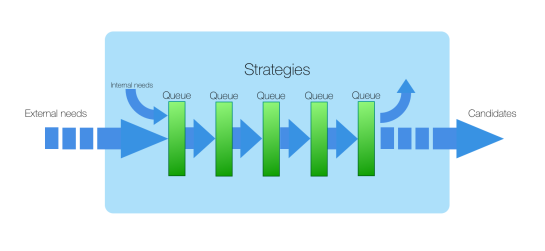Antimatter And The Marshall Model
OK. So there’s been some pretty strange titles to some of my blog posts. This one, not least. In my head, they make sense.
“How Effective is MY Organisation?”
When I’m explaining the Marshall Model, oftentimes folks will attempt to site their own organisations along the horizontal (relative effectiveness) axis. Whether it’s down to some kind of Dunning-Kruger effect, or something else, many times folks imagine their organisations as being much more effective than I – and the model – would suggest. For example, people in Ad-hoc organisations oftentimes imagine they’re in the “Synergistic” mindset. Still, looking on the bright side – at least these folks have connected with the question. Maybe for the first time ever.
For me, this is just a specific case of the widespread phenomenon of people thinking their organisations are much more effective than they actually are (i.e. relative to the world’s knowlege-work organisations as a whole).
Aside: It was noting this phenomenon, and its pernicious effect on organisations’ motivation to improve, that encouraged me to begin writing and talking about Rightshifting in the first place.
Differences
Recently, I’ve been tussling with how to express the stupendous differences in kind between the different mindsets of the Marshall Model. It’s these differences which in practice account for the huge variations in effectiveness between organisations of differing mindsets.
In this post I’m going to take a look at how the Antimatter Principle might help us understand the key difference between these mindsets. Firstly, to recap from the model:
- The one thing that most marks Ad-hoc organisations, is their lack of appreciation of the value of discipline.
- The one thing that most marks Analytic organisations is their lack of common, shared purpose.
- And the litmus test for Chaordic organisations – vs Synergistic ones – is their focus on seeking out and exploiting new opportunities. For example, new markets or new products. This seeking, above all, is their daily “business as usual”.
Ad-hoc Antimatter
In Ad-hoc organisations, folks’ needs might get attended to as a matter of common decency. I say might, because these organisations, by definition, will have no disciplines in place to address folks’ needs. Nor any common notion that this might be a good thing. So if someone has a bereavement, for example, the boss will most likely approach the situation as a one-off. So too with other things, such as staff promotions, individual performance, holidays, sick leave, bonuses, etc..
And so too with more prosaic issues, such as customer satisfaction (service) levels, billing, marketing, and so on. And in product development, ignorance – and thus absence – of e.g. cost of delay, flow, and other such “organisational” concepts.
This translates to organisations where nobody really knows where they stand. What to expect. Excepting common decency – or something else – from the boss.
Everybody can be pretty sure of one thing though, when the shit hits the fan, it’s the top dogs’ needs that count.
In a nutshell, the Ad-hoc organisation has few to zero disciplines relating to attending to folks’ needs.
Analytic Antimatter
In the Analytic-minded organisation, there will be policies and procedures to address folks’ needs. At least, some needs of some folks. Few Analytic-minded organisations will look at things expressly through the lens of the Antimatter Principle, to be sure. But in the matter of, for example, bereavement, staff promotions, individual performance, holidays, sick leave, bonuses, etc., these organisation will have a raft of gruesomely-detailed policies stipulating where folks stand.
In a nutshell, the Analytic organisation has some coercive, extrinsic disciplines relating to attending to folks’ needs.
Synergistic Antimatter
In Synergistic-minded organisations, there will be a widespread common understanding of how folks’ needs are attended to:
- Personal development plans and e.g. related quantified objectives may guide people in understanding their own needs and those of others, and thus to apply effort in attending to them.
- Team and group development capability or capacity plans may serve to guide folks in understanding and attending to the collective needs of groups.
- Project or product plans – a.k.a. requirements, use cases or user stories – may serve to identify the needs of consumers and other stakeholders in a particular project, product or product line.
- Financial plans may serve to address the finance-related needs of individuals and groups within and without the organisation.
- Strategic plans may serve to provide a common context (shared purpose) highlighting the needs of the organisation itself, and how folks’ individual and groups needs relate to that common purpose.
In a nutshell, the Synergistic organisation has a wide range of common, shared, non-obligaory, intrinsic disciplines relating to attending to folks’ needs. And folks’ self-discipline contributes to the continual discovery, and evolution of the understanding of folks’ needs – and the guidelines for attending to them.
Chaordic Antimatter
In a nutshell, the Chaordic organisation actively and continuously monitors folks’ needs, with a view to leveraging positive advantage (meeting more folks’ needs, more often, at less cost) as often as possible. This obviously applies to customers’ – and potential customers’ – needs. But I see no reason to stop there. The chaordic principle of positive opportunism offers benefits in regard to all stakeholders and their needs.
Summary
Has this post helped illuminate the distinctions between the various mindsets (memeplexes) of the Marshall Model? Are you now better placed to site your own organisation amongst its peers?
– Bob


